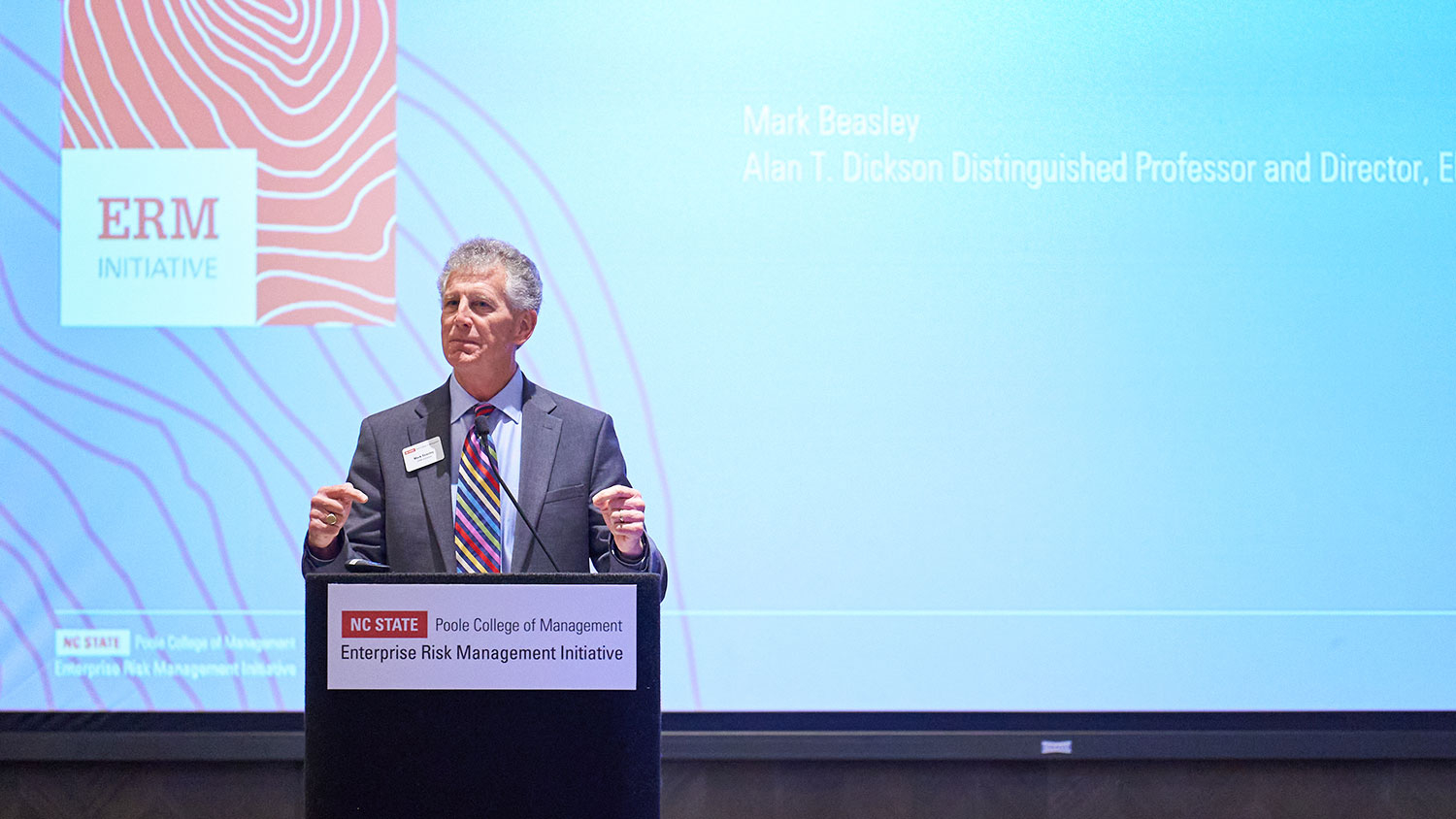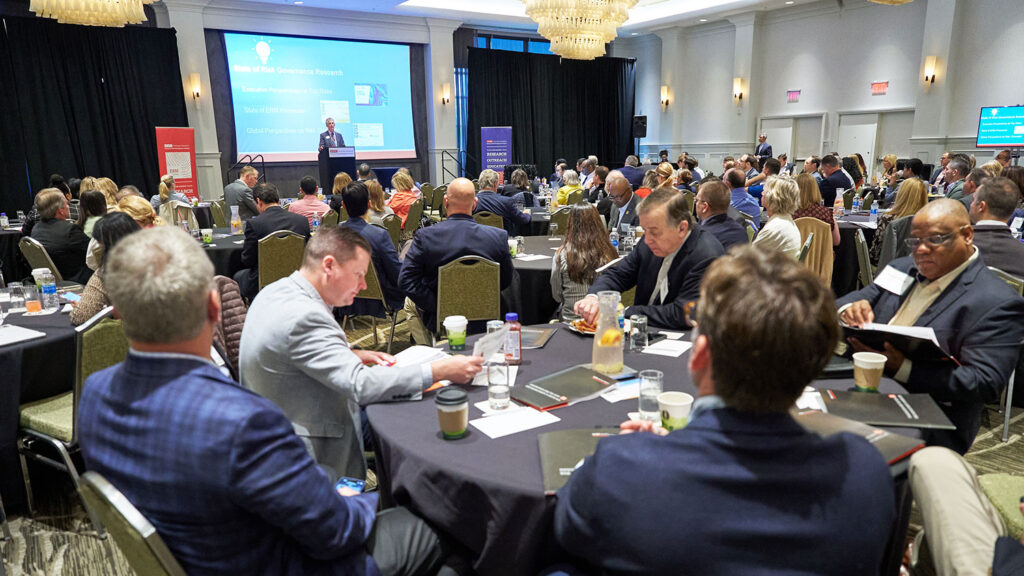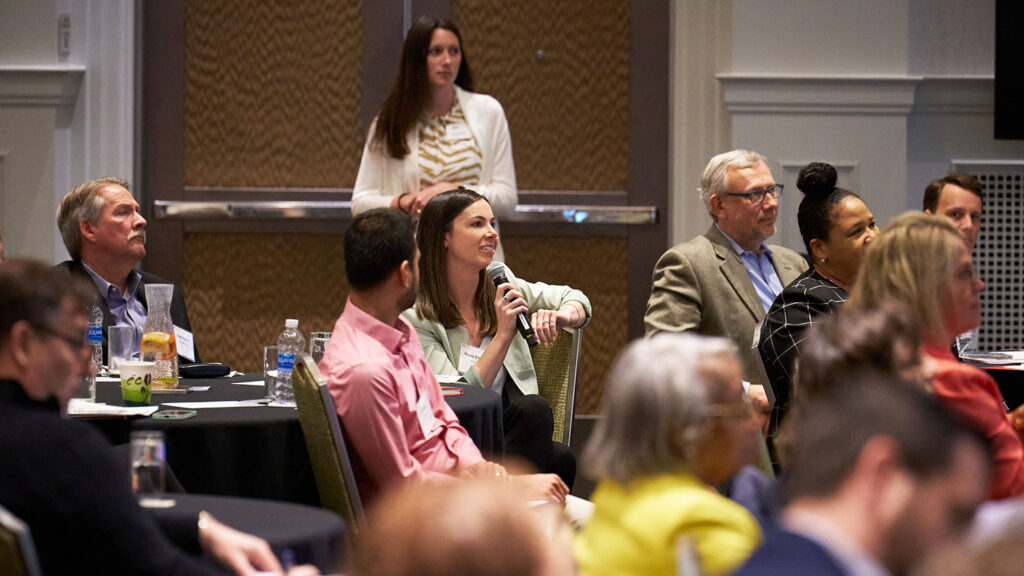ERM Initiative Celebrates 20th Anniversary at ERM Roundtable Summit

On Thursday, April 25, NC State celebrated the 20th anniversary of the Enterprise Risk Management (ERM) Initiative at the spring installment of the ERM Roundtable Summit. Held at the Renaissance Raleigh North Hills Hotel, the summit gathered more than 130 risk management professionals from across the nation and afforded industry practitioners the same opportunity the ERM Initiative has provided for two decades: to engage in thought leadership about emergent ERM issues to promote organizational resilience and success.
“The past 20 years have been a really exciting journey for us. It’s hard to believe that in 2004, our colleagues at Poole College first imagined going into this new space called ERM and putting on events like this one,” said Mark Beasley, professor of ERM and director of the ERM Initiative, to open the event.
Reflecting on the initiative’s humble beginnings, Beasley said the first event was a 20-person gathering in Nelson Hall with practitioners located within a few short miles of NC State’s campus. Catching a glimpse of the vision and seeing the potential of what it could become, however, Bank of America presented the university with a $1 million gift to get the ERM Initiative off the ground.
“Bank of America gave us the resources we needed to get this journey started. We are so thankful for their willingness to invest in what we were doing – and 20 years later, we’re seeing the fruit of that,” Beasley said. “Since we launched, we’ve had more than 50 roundtable events. When you think about that, you can imagine all the different stories and experiences we’ve heard – and what we’re doing now is trying to give that back to inform best practices moving forward. It’s a circular process.”
Assessing and Escalating Risk
Bill Fox, managing director and senior risk advisor for financial crimes at Bank of America, kicked off the summit as a representative of Bank of America’s 20-year support of the ERM Initiative.
Presenting on strengthening organizational resiliency to deflect financial risk, Fox explained that large financial institutions, because of their size, scale and reach, must stay vigilant about identifying, assessing and measuring risk.
“Risk is a discipline. You have to get to know your company’s discipline around it – and you have to take a disciplined approach to it,” he said. “A truly great risk manager starts with a disciplined, analytic approach. Facts first, then theories. Study what you know, then begin to ask questions about why this happened.”
This not only includes delineating risk within the context of the organization and determining where to put in the most time and effort – but escalating risk to the right people at the right time.
“This is where risk governance comes in. It doesn’t help if somebody knows something and they escalate it but it then gets stuck because it doesn’t get to the right people who have the capability to look and fix it. Making sure you have a culture of escalation is important,” Fox said.

Strengthening Agility and Sustainability
Coral Gottlieb, senior director of enterprise resilience at Levi Strauss & Co., added that the level of risk is increasing for organizations as external risks, such as geopolitical conflicts, government sanctions and privacy laws, are intensifying.
The lack of control over these risks, as well as the complexity and cross-functional nature of these risks, makes ERM essential for organizational resilience, Gottlieb says. Levi Strauss & Co. is taking steps to become more agile in this environment by linking resiliency functions to robust ERM practices and programs, streamlining processes and activating business continuity plans – such as how to respond to the loss of suppliers.
“You might not be able to guess that next big event, but if you’re strengthening your processes, hopefully that big event won’t have as big of an impact on you,” Gottlieb said.
Gottlieb challenged risk managers to avoid complicating ERM, use everyday business language rather than academic terms and risk jargon, reduce redundancy in their business units and connect ERM to strategy. She also encouraged risk managers to keep an ear to the ground, test response plans, identify gaps and implement quick wins.
“I’ve seen a lot of crises and the one area you can typically always do better in is your communication,” Gottlieb said. “Who did you communicate to and when? Was it the right time to engage? Did you miss any key stakeholders? Have you predetermined who will own the communication?”
Chris Turpin, ERM and insurance manager for British American Tobacco (BAT) Company, also highlighted the importance of improving communication with stakeholders. In a session on integrating ERM and sustainability, Turpin discussed BAT’s global manufacturing footprint, evolving regulatory requirements and investors’ increasing environmental, social and governance (ESG) interests. Because of these realities, he said, BAT is committed to embedding sustainability principles in the company’s different brands, aligning its overall strategy with stakeholder interests and addressing investor concerns in sustainability reports.
“Getting this wrong is not an option, so we’ve set high benchmarks across our sustainability targets. There are numerous penalties for losing investor confidence,” Turpin said.
Taking Strategic Risks
Following a networking lunch, Mike Pfister, head of the development center for the International Committee of the Red Cross (ICRC), discussed the importance of partnering for sustainable impact in high-risk areas.
Showing a moving video about protecting hospitals in war zones, Pfister explained ICRC’s commitment to protecting people in areas of armed conflict and the complexity of this work. The world currently experiences the highest number of violent conflicts since World War II, he explained, and according to The World Economic Forum’s Global Risk Report 2024, interstate armed conflict is one of the top 10 risks for the next two years.
To continue the ICRC’s essential work, Pfister said the organization must instill a systemic shift in how it operates. “There has always been a focus on how we have this massive humanitarian crisis and need funding. For decades, that has been the push – ‘We operate, you fundraise.’ But we realize now that’s not enough,” he said.
Increasing partnerships with other organizations, rather than operating alone, is an important step forward – but also a risky one. Because its mission is to protect people, ICRC must remain neutral and impartial to keep contacts on all sides and retain access to various regions. Although partnering with other organizations can complicate this, development actors can help the ICRC expand its impact amidst escalating risk.
According to Emily Perzanoski, a graduate student in the Master of Management, Risk and Analytics (MRA) program, this was one of the highlights.
“It’s easy to think about risk management as only risk prevention, but the presenters continually emphasized the value of taking risks when they have been evaluated effectively,” she said. “Risk management helps organizations stay ahead of the curve in their industries and gain a strategic objective where it matters most.”

Improving Data Visualization
In the summit’s final session, Yogi Verma, senior vice president of ERM at PRA Group, Inc., discussed communication with board members about organizational risk. The key to facilitating meaningful risk conversations with decision-makers? Better, simpler data visualization.
“One of the greatest commodities these days is attention. We have more data than ever before and our attention spans are decreasing off the charts,” Verma said. “Visuals are a much more effective way of communicating – and you can utilize that when presenting risk to the board.”
Heat maps and 3D charts, Verma said, overly complicate decision-making – whereas line charts that demonstrate change over time, vertical bar charts that present categorical data, horizontal bar charts that emphasize rankings and pie charts that demonstrate a part-to-whole relationship are easy to interpret. Incorporating visual contrast and Gestalt Principles of Visual Perception can also amplify communication by drawing the eyes of leaders to the most important information.
At the end of the day, Verma said, risk management is all about decision management and reporting. That’s why reducing the cognitive burden on decision-makers, and preparing self-explanatory visuals that reveal the underlying story behind the data, is so important.
“You don’t want to make a leader work hard to understand the data in front of them. Make it easy,” he said. “Simple is powerful.”
Creating a Brighter Future
Frank Buckless, Stephen P. Zelnak Jr. Dean of Poole College of Management, closed the summit with a few reflections on how events like the biannual ERM Roundtable Summit drive Poole College’s mission forward – and the tremendous growth the ERM Initiative has seen in the last 20 years.
“As a college, our mission is to develop innovative leaders, create world-class research and create a better place to live and work. Making better connections between academics and industry is a key way we do that. It ensures the research we do develops practical insights people can use in the real world,” he said.
“I remember our first meeting in 2004 – Mark was on the COSO board and the ERM framework had just come out. It was brand-new stuff, but we figured it would be a need in the marketplace and we had leaders with the ability to make a difference,” he continued. “Twenty years later and we have become a global thought leader in this space – and what really excites me is that the future is even brighter.”
This post was originally published in Poole Thought Leadership.
- Categories: